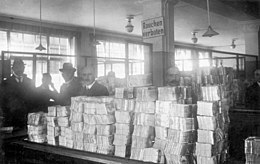
Back التضخم الجامح في جمهورية فايمار Arabic Hiperinflación na República de Weimar AST Хиперинфлация във Ваймарската република Bulgarian Hiperinflació alemanya Catalan Deutsche Inflation 1914 bis 1923 German Hiperinflación en la República de Weimar Spanish Weimarko Errepublikako hiperinflazioa Basque ابرتورم در جمهوری وایمار Persian Hyperinflation de la république de Weimar French Hiperinflación na República de Weimar Galician

Hyperinflation affected the German Papiermark, the currency of the Weimar Republic, between 1921 and 1923, primarily in 1923. The German currency had seen significant inflation during the First World War due to the way in which the German government funded its war effort through borrowing, with debts of 156 billion marks by 1918. This national debt was substantially increased by 50 billion marks of reparations payable in cash and in-kind (e.g., with coal and timber) under the May 1921 London Schedule of Payments agreed after the Versailles treaty.
This inflation continued into the post-war period, particularly when in August 1921 the German central bank began buying hard cash with paper currency at any price, which they claimed was to pay reparations in hard cash, though little in the way of cash reparations payments were made until 1924. The currency stabilised in early 1922, but then hyperinflation took off: the exchange value of the mark fell from 320 marks per dollar in mid 1922 to 7,400 marks per US dollar by December 1922. This hyperinflation continued into 1923, and by November 1923, one US dollar was worth 4,210,500,000,000 marks. Various measures were introduced by German authorities to address this, including a new currency called the Rentenmark, backed by mortgage bonds, later itself replaced by the Reichsmark, and the blocking of the national bank from printing further paper currency.
By 1924 the currency had stabilised and German reparations payments began again under the Dawes Plan. As the catastrophic fall in the value of the mark had effectively wiped out debts owed, some debts (e.g. mortgages) were revalued so that the lenders could recoup some of their money.
Hyperinflation caused considerable internal political instability in the country. Historians and economists are divided on the causes of this hyperinflation, particularly the extent to which it was caused by reparations payments.